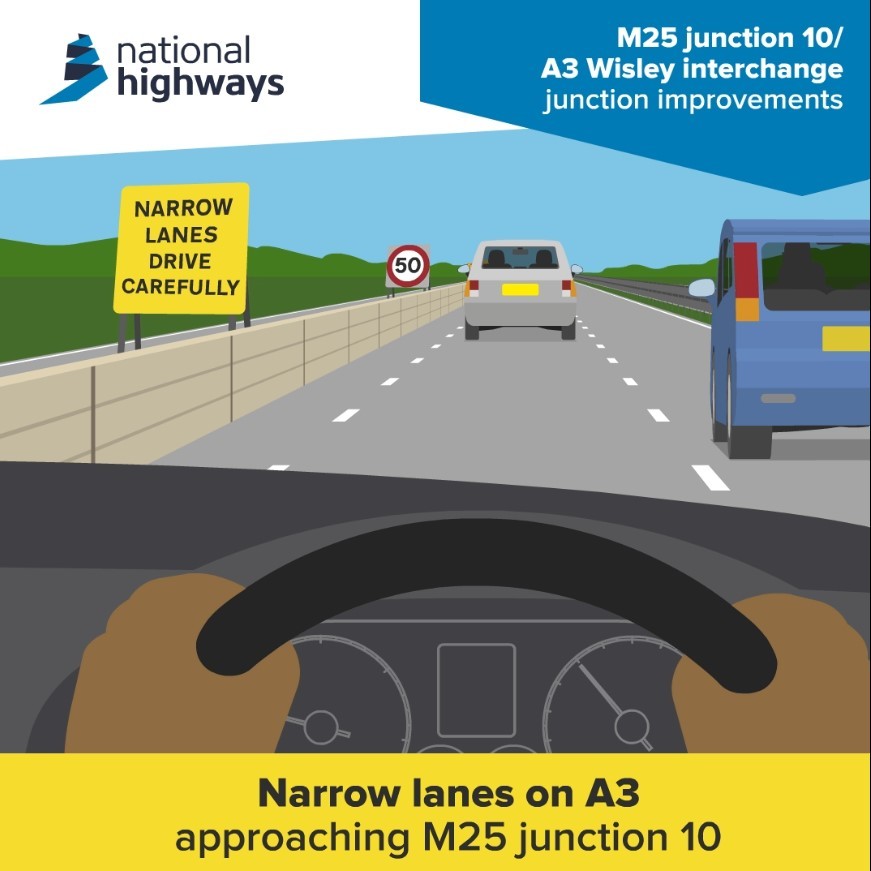|
Welcome to our latest update on our improvements to M25 junction 10/A3 Wisley interchange.
What’s been happening?
You may have noticed that we’ve been busy getting ready to start our main work. We wanted to let you know about some changes that you will start see on the A3 and M25 in the new year.
From January, we’ll be introducing temporary changes to the road layout around M25 junction 10/A3 Wisley interchange to help keep traffic flowing smoothly and create a safe working area for our team. We’ll be putting in narrow lanes and reducing the speed limit to 50 mph on the A3 on both sides of the junction, and the M25 as it passes through junction 10. This will ensure that we can continue to keep the same number of lanes open, and create a safe working space for our team. We’ll be sharing more details about these closures soon.
 We’ll still need to carry out some overnight closures in December for our preparation work and you can find out more information about these on our webpage. We apologise for any inconvenience these closures may cause.
We’ve already started working around the common areas, and at times you may find that we have diversion routes in place to allow us to carry out our work.
We’re getting ready to move into our main project office at Nutberry Farm in December. We’ll usually work between 7:30am and 6pm Mondays to Fridays, and 8am to 7pm on Saturdays, so there may be times when you won’t see anyone on site.
For safety reasons we’ll be closing the pedestrian crossings on the M25 junction 10 roundabout from late January, and a diversion will be in place over the Clearmount Bridge. We’re delivering longer term improvements to the local network of footpaths and bridleways. You can find out more about this work on our factsheet.
Heathland restoration and replacing lost habitats
It is necessary to take some land and remove trees to build our scheme, however we’ll be replacing this land on a like for like basis so there will be no overall loss of common area or Special Protection Areas (SPA) because of the scheme.
The A3 will be widened into the central reservation at it passes the RHS Gardens Wisley, not only avoiding the trees along the A3 boundary but also protecting the extensive and vital root structure under them.
We’ll also be restoring large areas of Heathland at Ockham and Wisley commons. Heathland is one of the UK’s most threatened environments and is a vital habitat for a wide range of invertebrates, reptiles and bird species. To restore the heathland and bring it back to life we will be clearing areas of pine dominated woodland to allow the heather to regenerate. You can find out more about these improvements on our webpage.
 Restored heathland
Local students help us design the Cockcrow Bridge
Local students have become part of our design team on our M25 junction 10/A3 Wisley interchange improvements.
The scheme will be building the UK’s first heathland bridge. Spanning 30 metres across, the same size as nearly four double decker buses, the Cockcrow Heathland bridge will pass over the M25, linking two key wildlife areas at Ockham and Wisley. The new bridge will not only provide a safe crossing for pedestrians, cyclists and horse riders, but also creatures and animals.
Local primary school students were recently challenged to help our team working on the design of the bridge by drawing some of the animals, flora and fauna that might call the heathland their home. We’ll then use some of these designs on the steel sides of the bridge.
We’ve been overwhelmed to receive more than 230 drawing ranging from foxes and weasels to badgers and rabbits. We’re going to have a tough job picking out which ones we use on the bridge!
 The team sort through the drawings submitted by local students
Reminder on why we are improving the M25 Junction 10/A3 Wisley interchange
Junction 10 is one of the busiest sections of the M25, with almost 300,000 vehicles travelling through it every day. Due to the volume of traffic and the resulting queues, this area of our network has a very poor safety record and holds one of the highest collision rates across the National Highways network. Our scheme will reduce delays, smooth traffic flow and create safer journeys for all. Our improvements will be completed by summer 2025.
Travelling when it's raining
We’ve experienced quite a bit of rain over the last few weeks so we thoughts we would share some tips for driving safely in the rain. Rain can affect your ability to see ahead or be seen by others. It can also affect your vehicle’s performance and responsiveness.
- If it’s time for your wipers, it’s time to slow down.
- Use dipped headlights, especially if visibility is seriously reduced.
- The roads will be more slippery than usual, so give yourself more time to react - increase the gap between you and the vehicle in front to at least four seconds.
- Look out for standing water and adjust your driving.
- Keep your eyes on the road at all times - spray from other vehicles can suddenly reduce your visibility.
- Visibility affects others too, so anticipate their actions and be prepared.
- During thunderstorms, sudden gusty winds can unsettle vehicles. Keep your speed down and give other road users more room.
We also do our bit when heavy rain is forecast, we check culverts, gulleys and drains to help ensure rainwater can drain off the road surface and avoid flooding. Our traffic officers, inspectors, and control room teams routinely monitor the weather and respond to any changing road conditions. For more information please visit our road safety webpage.
|